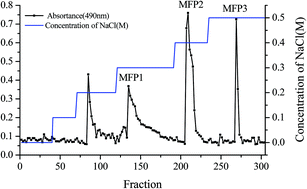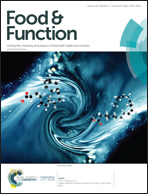Fructus mori L. polysaccharide-iron chelates formed by self-embedding with iron(iii) as the core exhibit good antioxidant activity
Abstract
Mulberry fruit polysaccharide (MFP) was obtained from Morus alba L. by a hot water extraction method, and mulberry polysaccharide fractions named MFP1, MFP2 and MFP3 were isolated by DEAE cellulose-52 column chromatography. Monosaccharide analysis of MFP1, MFP2 and MFP3 showed that the three components had the same monosaccharide compositions with different ratios, and galacturonic acid was the main monosaccharide component. Molecular weight measurements showed that MFP1 and MFP2 are heteropolysaccharides and MFP3 is a homogeneous polysaccharide. In addition, the chelate mechanism of iron(III) and polysaccharide is proposed in which iron(III) as a core is enwrapped by the polysaccharide as a ligand by hydroxyl and carboxyl groups, which induces a morphology change from flat sheets to rods and increases the size. Furthermore, the polysaccharides showed strong antioxidant activity to eliminate hydroxyl radicals and inhibit MDA production in healthy mouse liver homogenate. Also, the polysaccharide-iron(III) chelates exhibited stronger superoxide radical scavenging ability than the polysaccharides. These results suggest that the polysaccharides derived from Morus alba L. are promising candidates for fabricating organic iron supplements with good antioxidant activity.



 Please wait while we load your content...
Please wait while we load your content...